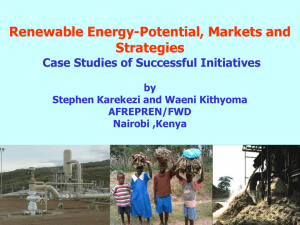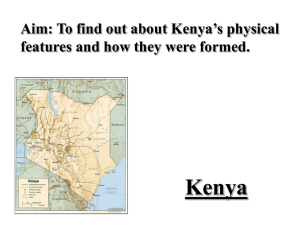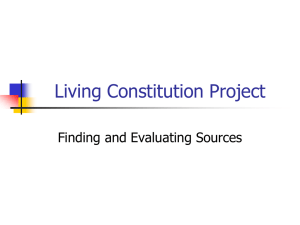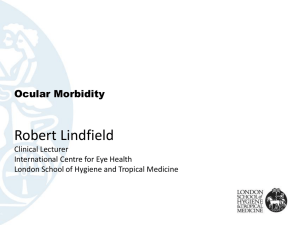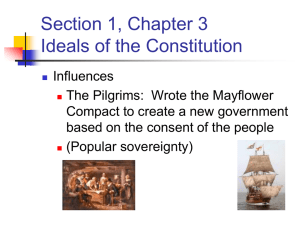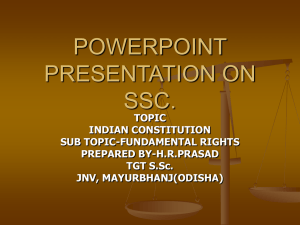“Land, Environment and Natural Resources”, Rapid Results Initiative
advertisement
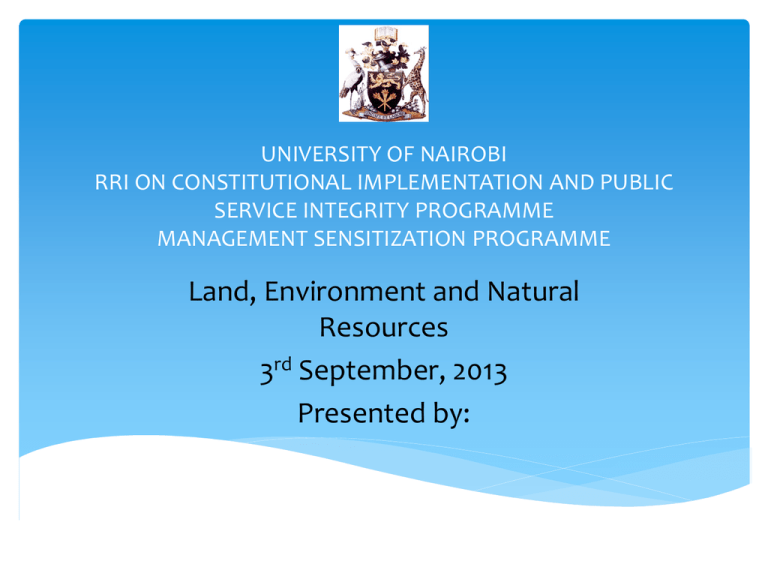
UNIVERSITY OF NAIROBI RRI ON CONSTITUTIONAL IMPLEMENTATION AND PUBLIC SERVICE INTEGRITY PROGRAMME MANAGEMENT SENSITIZATION PROGRAMME Land, Environment and Natural Resources 3rd September, 2013 Presented by: The University of Nairobi TEAM MEMBERS Dr. Winifred Kamau (TL) Prof. Patricia Kameri-Mbote, Dr. Daniel Ichang’i, Dr. Winnie Mwangi Dr. Robert Kibugi University of Nairobi ISO 9001:2008 2 Certified http://www.uonbi.ac.ke Significance of Land Land is an emotive issue in Kenya Significance of land and land based resources for livelihood, identity, security Land is not just a commodity that can be traded in the market. It represents multiple values which should be protected by both policy and law o o o o An economic resource that should be managed productively A significant resource for equitable access of livelihood A finite resource which should be utilised sustainably A cultural heritage which should be conserved for future generations o Has social, cultural and religious significance for individuals, families and communities Historical and contemporary context of land relations Legacy of unlawful acquisition of public and community lands by the colonial administration Continued dispossession in post-colonial era: squatters, landlessness; informal settlements Issue of land rights for minority and marginalized groups, e.g. women, pastoralist groups, indigenous communities Sub-regional issues – e.g. Coast, pastoral areas, Politically instigated land clashes; internally displaced persons, etc. Complexity of multiple land regimes including customary land tenure Weak legal framework: proliferation of scattered and uncoordinated land laws Weak and corrupt institutions of land administration and management; Weak institutional enforcement; state capture Slow/repetitive/inaccessible land administration processes Land grabbing; double allocation of titles Environmental degradation and poor land use practices Q: As a landowner, has UoN been affected by any of these? How does the University approach teaching and research on these land questions? What is Land? Space that encompasses the surface of the earth and all things that are attached to it, Land includes areas covered by water such as seas and lakes, as well as the air space above it Includes all natural resources found on it, such as rocks and minerals that are just below it and all natural vegetation. Also includes buildings and and other permanent attachments Legally, it includes the physical and abstract attributes such as rights and interests embedded thereon (“bundle of rights”). Rights include ownership, access and use Constitution and Land Constitutional definition of the term “land” in Art. 260:“land” includes— (a) the surface of the earth and the subsurface rock; (b) any body of water on or under the surface; (c) marine waters in the territorial sea and exclusive economic zone; (d) natural resources completely contained on or under the surface; and (e) the air space above the surface; Constitution of Kenya, 2010 Represents a new era in dealing with land relations Recognizes the unique and complex nature of land: land no longer seen merely as “property” in contrast to the repealed Constitution Attempts to deal with some of the historical exclusions/injustices relating to land Contains an entire chapter on land, i.e. Chapter 5 entitled “Land and Environment” Part 1 is on land (Arts. 60 – 68) Part 2 is on environment and natural resources (Arts. 69 – 72) Changes brought by the Constitution of 2010: 1. - - Introduces progressive principles of land policy Art. 60: Land in Kenya to be held, used and managed in a manner that is equitable, efficient, productive and sustainable in accordance with the following principles: Equitable access to land Security of land rights Sustainable and productive management of land resources Transparent and cost effective administration of land Sound conservation and protection of ecologically sensitive areas Elimination of gender discrimination in laws, customs and practices related to land Encouragement of communities to settle land disputes through recognized local community initiatives Changes brought by the Constitution 2. Ownership of land is vested in the people (Wanjiku) Art. 61 (1): All land in Kenya belongs to the people of Kenya collectively as a nation, as communities and as individuals. Art. 62: all public land (whether held by the national or county government) is held in trust for the people Contrast: the old legal regime where land was vested in the Commissioner of Lands on behalf of the State (in the person of the President) Changes brought by the Constitution 3. Introduces new classification of land Art. 61 (2): Land classified as: a) Public land – Art. 62: unalienated land; land held by State organs; minerals and mineral oils and other natural resources b) Community land – Art. 63 – land vested in and held by communities identified on the basis of ethnicity, culture or similar community of interest. Community land recognized for the first time c) Private land – Art. 64 – land held under freehold or leasehold tenure Q: Under what tenures does UoN hold its rights to land and how are they secured? Changes brought by the Constitution 4. Imposes limitations on rights of land ownership and use: - Limits on land tenure by non-citizens: maximum of 99 year leases (Art. 65); previously ran to 999 years - Envisages limits on land sizes - Parliament to prescribe minimum and maximum holdings (Art. 68(c)) 5. Seeks to promote gender equality: particularly the matrimonial home as well as the intereselimination of gender discrimination in law, customs and practices related to land and protect (Art. 60); protects interests of spouses in matrimonial property,ts of dependants of deceased persons (Art. 68 c) Changes brought by the Constitution 6. Secures protection of the right to property Art. 40: Every person has the right to acquire and own property of any description and in any part of Kenya (subject to Art. 65 relating to non-citizens) No arbitrary deprivation of property – there must be prompt, full and just compensation Right to access to a court of law Property rights extended to intellectual property Art. 43 (1)(b): every person is entitled to ‘accessible and adequate housing’- inherent in this right is provision of secure land tenure. 7. Opens up possibility for review of titles to determine their propriety or legality Art. 68 – unlike in the past where sanctity of title was upheld irrespective of means of acquisition National Land Policy Provided for in Art. 60 – principles to be implemented through a national land policy developed and reviewed regularly by the national government National Land Policy predated Constitution: Sessional Paper No. 3 of 2009 The Policy is a milestone in the land sector as it promises to tackle the issues that have negatively hounded the land sector since independence. It addresses the following issues; land laws, land tenure, land administration and land information management systems, land use planning, areas requiring special intervention (marginalized groups/historical injustices and institutional framework National Land Policy Policy provides a broad framework and set of values to guide sectoral, legislative and institutional reforms in land administration and management. Entails a rethinking of land relations in Kenya with a view to laying a firm foundation for use of land in a productive, efficient, equitable and sustainable manner. National Land Policy Land Reform Principles in the Land Policy 1. Redistribution: purpose is to facilitate equitable access to land for residential purposes 2. Restitution: purpose is to restore land rights to those that have unjustly been deprived of such rights 3. Resettlement: seeks to procure adequate land for reorganisation of both rural and urban settlements in light of expanding population, conflicts, historical injustices and disasters 4. Land Banking 5. Benefit sharing 6. Land taxation Q: To what extent does the Constitution and legal framework effectively deal with land issues? University of Nairobi ISO 9001:2008 15 Certified http://www.uonbi.ac.ke Legal Framework on land Principles of Land Policy Public Land Constitution Substantive Land law Registration processes Community Land Community management of land Private Land Registration of Land Act Land Act Legislation on Land National Land Commission Act New Legal Framework Previously, land law consisted of numerous pieces of legislation Constitution provides for revision, consolidation and rationalization of existing legislation (Art. 68) Schedule 5 – land laws to be passed within 18 months of passing of the Constitution Pursuant to this, Parliament has repealed several land laws and enacted the following new legislation Land Act Land Registration Act National Land Commission Act Environment and Land Courts Act New Legal Framework The National Land Commission Act, 2012: aims at providing the institutional framework for the management and administration of land in Kenya; The Land Act, 2012 -consolidates the substantive land law in the repealed Acts; The Land Registration Act, 2012 -Consolidates and harmonizes the land registration provisions in the repealed statutes. The Environment and Land Court Act, 2012 - gives effect to Article 162(2)(b) of the Constitution; establishes a superior court with status of the High Court to hear and determine disputes relating to the environment and the use and occupation of, and title to, land. Proposed legislation Community Land Bill– provides for matters relating to community land Evictions and Resettlement Bill –provides for procedures on evictions and protection of rights to property Matrimonial Property Bill, 2013- Provides for the rights and responsibilities of spouses in relation to matrimonial property New land institutions National Land Commission County Registrars County Land Management Boards County Governments Environment and Land Court National Land Commission Established by Art. 67 of the Constitution Operationalized by National Land Commission Act, 2012 Functions include: –to manage public land on behalf of the national and country governments (Art. 62 (2) and (3) - to conduct research related to land and the use of natural resources - to initiate investigations into present or historical land injustices - to encourage application of traditional dispute resolution mechanisms in land conflicts - to monitor and have oversight responsibilities over land use planning University of Nairobi ISO 9001:2008 21 Certified http://www.uonbi.ac.ke Management and administration of land in a devolved context: Role of national government - formulation of policies, legislation and institutional frameworks on management and administration of land Role of County governments - Implementation of land management and administration policies and programmes : County land management boards- sanction, approve and monitor land development proposals Management and administration of land in a devolved context: Art. 62 (2) Certain categories of public land shall vest in and be held by county governments in trust for the people resident in the county Categories are: unalienated government land; land transferred to the State by way of sale, reversion or surrender; land in respect of which there is no established individual or community ownership or heir land held or occupied by a State organ (other than a national State organ) Management and administration of land in a devolved context Art. 62 (3) Categories of public land which shall vest in and be held by the national government in trust for the people of Kenya These consist primarily of: Natural resources such as: minerals and mineral oils; government forests, game reserves, water catchment areas, rivers, lakes, territorial sea, exclusive economic zone and the sea bed, All roads and thoroughfares provided for by an Act of Parliament Land Management and Administration in the Context of Devolution Schedule 4 of Constitution: Distribution of functions between county and national governments Functions and powers of National government: i) Intellectual property rights ii) General principles of land planning and coordination of policy by the counties iii) Protection of the environment and natural resources with a view to establishing a durable and sustainable system of development, including in particular: a) fishing, hunting and gathering b) Protection of animals and wildlife c) Water protection, securing sufficient residual water, hydraulic engineering and the safety of dams; and d) Energy policy including electricity and gas reticulation and energy regulation Land Management and Administration in the Context of Devolution Functions and powers of county governments Agriculture, including fisheries Control of air pollution, noise pollution, other public nuisances County planning and development, including land survey and mapping, boundaries and fencing, housing, electricity and gas reticulation and energy regulation Implementation of specific national government policies on natural resources and environmental conservation, including soil and water conservation and forestry University of Nairobi ISO 9001:2008 26 Certified http://www.uonbi.ac.ke Dispute Resolution Cf: Art. 159: Principles - Need to ensure access to timely, efficient and affordable dispute resolution mechanisms Environment and Land Court: special jurisdiction National Environment Tribunal Traditional dispute resolution mechanisms, (Art. 60) Alternative dispute resolution methods, including mediation, arbitration (Art. 259) Environment and Natural Resources Meaning of environment Environment has a very broad meaning and includes: the physical factors of the surroundings of human beings including land, water, atmosphere, sound, odour, taste, the biological factors of animals and plants; and the social factors of aesthetics, and includes both the natural and the built environment. Environment Significance of the environment Crucial for the survival and socio-economic wellbeing of mankind Fragility of ecosystems requires care for the environment Finite resources, therefore need to be properly managed and used in a sustainable manner Environmental degradation in Kenya stems from two main types of human activities: Use of resources at unsustainable levels; and Contamination of the environment through pollution and waste at levels beyond the capacity of the environment to absorb them or render them harmless. Constitution of Kenya The Constitution marks a fundamental change in approach regarding the environment. Preamble: recognition of the need to respect and sustain the environment for the benefit of future generations. Art. 10 National values and principles of governance in the Constitution includes the principle of sustainable development. Sustainable development is development that meets the needs of the present without compromising the ability of future generations to meet their own needs. Constitution of Kenya Art. 60(1) stipulates that land should be held, used and managed in accordance with the principle of sound conservation and protection of ecologically sensitive areas. Art. 42: Right to a clean and healthy environment (constitutionally protected for the first time) Art. 70: Right may be enforced in a court of law – locus standi (right of standing) in court made easy Constitution of Kenya Article 69: State obligations with regard to the environment: Ensure sustainable exploitation, utilization, management and conservation of the environment and natural resources and ensure the equitable sharing of the accruing benefits Work to achieve and maintain a tree cover of at least 10% of the land area of Kenya Protect and enhance intellectual property in, and indigenous knowledge of biodiversity and genetic resources and biological diversity Establish systems of environmental impact assessment, environmental audit and monitoring of the environment Eliminate processes and activities that are likely to endanger the environment Utilize the environment and natural resources for the benefit of the people of Kenya Legal Framework Environmental Management and Coordination Act, 1999 (EMCA) Framework law which establishes the legal and institutional framework for the coordination of diverse sectoral initiatives for the conservation and management of the environment in Kenya. Establishes National Environment Management Authority (NEMA) Sectoral laws: There are various sectoral laws relating to the environment. These regulate agricultural, water, forests, trade, health, mining and industry sectors which have significant implications on the environment. Natural Resources Development and Management Policy, 2013 – envisages legislation providing a framework architecture in the management, coordination and regulation of natural resources in Kenya National Environment Policy (draft) International obligations which has ratified (significance in light of Art. 2 (6) ) Natural Resources Importance of natural resources for livelihood and economic development Kenya has diverse natural resources, namely: Biodiversity in its widest sense, including fisheries, etc; Forest and Water Towers; Wildlife; Water; Industrial Minerals and Rocks e.g. limestone, trona, feldspar, mica, salt, etc. Ore (Metallic)Minerals e.g. gold, copper, zinc, iron, titanium, uranium, niobium and rare earth metals, etc. Gemstones. Energy Resources: Coal, Oil and Gas, Geothermal resources, Wind, Sunlight, the Ocean Recent discoveries of oil and valuable minerals Holds potential for economic transformation of Kenya. Need to develop our natural resources in a way that benefits all the Kenyan people and avoid the “resource curse” Constitution of Kenya Art. 260: “natural resources” means the physical non-human factors and components, whether renewable or non-renewable, including— (a) sunlight; (b) surface and groundwater; (c) forests, biodiversity and genetic resources; and (d) rocks, minerals, fossil fuels and other sources of energy; Article 62 (1): Natural resources included within public land, e.g. All minerals and mineral oil Forests National parks and game reserves Natural resources included as part of the definition of land in Art. 260 Constitution of Kenya Article 67(1) (d): National Land Commission is mandated to conduct research related to land and use of natural resources and to make recommendations to appropriate authorities Article 71 (1) and (2): Parliament is responsible for ratifying grant of rights or concessions for exploitation of any natural resources in Kenya Role of the University of Nairobi Internal governance and management of land, environment and natural resources Adopt policies and align existing ones to the Constitution – Land use policy Environment policy Natural resources policy Sustainable land use – e.g Conservation of own lands. planned increase of tree cover in its own lands Comply with requirements of NEMA regarding environmental standards, environmental impact assessments etc. Ensure security of tenure for its own properties Ensure real property is optimally utilized Document and keep inventories on UoN’s properties University Role of the University of Nairobi Research, training and capacity building Conduct Research related to land and use of natural resources: see Art. 67 (2) (d); Audit and collation of data Training and capacity building: e.g.lawyers in relation to concessions, contracts; engineers, geologists, environment professionals Regional and international collaborative partnerships in capacity building and research in the area of natural resources are a priority in order to create wealth for Kenya and employment for the youth. Protection of intellectual property rights Preservation of indigenous knowledge University of Nairobi ISO 9001:2008 38 Certified http://www.uonbi.ac.ke Role of the University of Nairobi For Mineral Resources, for example, what is now required is research into the typology, geologic setting, genesis and controls of economic mineralization and of oil and gas in the country. For other natural resources, a multi-skill and dimensional approach should be adopted and incorporate all sectoral experts in formulating policies and consultancies, most of whom are domiciled within the UoN As a matter of priority, build capacity to handle the vast mineral resources from the East and Central African region by turning Kenya into a Logistics, processing and trading hub. University of Nairobi is a crucial cog in this effort. Summary on Role of University Contribution to National, Regional and International Efforts Contribute to policy formulation in land, environment and national resources Offer leadership in capacity building, research and training in the key sectors Spearhead environmental conservation efforts Create environmental awareness University of Nairobi ISO 9001:2008 40 Certified http://www.uonbi.ac.ke THE END Thank you! University of Nairobi ISO 9001:2008 41 Certified http://www.uonbi.ac.ke
